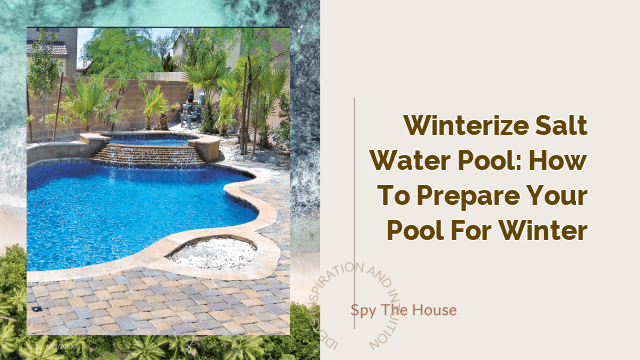Winterize Salt Water Pool: How to Prepare Your Pool for Winter
As the winter season approaches, it’s important to prepare your salt water pool to prevent damage and ensure that it’s ready for use when the warm weather returns. Winterizing a salt water pool involves a series of steps to protect the pool from freezing temperatures, prevent algae growth, and keep the water clean and clear. In this article, we’ll discuss everything you need to know about winterizing your salt water pool.
What does it mean to Winterize a Salt Water Pool?
Winterizing a salt water pool means preparing the pool for the winter season by taking steps to protect it from damage caused by freezing temperatures. This involves removing water from the pool’s plumbing and equipment, adding winter chemicals to prevent algae growth, and covering the pool to keep it clean and clear. It’s important to winterize your pool before the temperature drops below freezing to prevent costly repairs and ensure that your pool is ready for use when the weather warms up.
Step-by-Step Guide to Winterize Salt Water Pool
Winterizing a salt water pool involves several steps to ensure that the pool is properly protected during the winter season. Here’s a step-by-step guide to winterizing your salt water pool:
Step 1: Test the Water Chemistry
Before you begin the winterization process, it’s important to test the water chemistry to ensure that it’s balanced. Test the pH, total alkalinity, and calcium hardness levels of the water and adjust them if necessary. The ideal pH range for salt water pools is 7.4-7.6, while the total alkalinity should be between 80-120 ppm and the calcium hardness between 200-400 ppm.
Step 2: Clean the Pool
Clean the pool thoroughly by brushing the walls and floor and vacuuming any debris. Skim the surface to remove leaves and other debris, and clean the filter to ensure that it’s working properly. You may also need to shock the pool to remove any bacteria or algae that may be present.
Step 3: Lower the Water Level
Lower the water level in the pool to below the skimmer and return lines to prevent them from freezing and causing damage. Use a submersible pump or drain the pool with a hose until the water level is below the recommended level.
Step 4: Drain the Plumbing and Equipment
Drain the pool’s plumbing and equipment to prevent damage from freezing temperatures. This includes the pump, filter, heater, and any other equipment that contains water. Follow the manufacturer’s instructions for draining each piece of equipment to ensure that it’s done properly.
Step 5: Add Winter Chemicals
Add winter chemicals to the pool to prevent algae growth and keep the water clean and clear. This includes adding a winter algaecide, a stain and scale inhibitor, and a winterizing chemical kit. Follow the manufacturer’s instructions for adding each chemical to ensure that it’s done properly.
Step 6: Cover the Pool
Cover the pool with a winter cover to keep it clean and clear during the winter season. Make sure that the cover is securely fastened to prevent debris from entering the pool. If you live in an area with heavy snowfall, consider using a cover pump to remove excess water from the cover to prevent it from collapsing.
Tips for Winterizing Salt Water Pool
Here are some additional tips to help you successfully winterize your salt water pool:
Tip 1: Start Early
Start the winterization process early to ensure that the pool is properly protected before the temperature drops below freezing. This will help prevent costly repairs and ensure that your pool is ready to use when the weather warms up.
Tip 2: Use a Winterizing Chemical Kit
Use a winterizing chemical kit to ensure that the pool is properly balanced and protected during the winter season. These kits contain all the chemicals you need to winterize your pool and are designed to prevent algae growth and keep the water clean and clear.
Tip 3: Remove Debris and Clean the Cover
Remove any debris that accumulates on the pool cover during the winter season to prevent it from entering the pool. Clean the cover periodically to prevent the growth of mold and mildew.
Tip 4: Check the Pool Periodically
Check the pool periodically during the winter season to ensure that the cover is in place and that the water level is stable. If you notice any issues, take corrective action immediately to prevent damage to the pool.
Frequently Asked Questions About Winterizing a Salt Water Pool
Here are some frequently asked questions about winterizing a salt water pool:
Q: When should I winterize my salt water pool?
A: You should winterize your salt water pool before the temperature drops below freezing. This is usually in late fall or early winter, depending on your location.
Q: Can I use regular pool chemicals to winterize my salt water pool?
A: No, you should use winterizing chemicals that are specifically designed for salt water pools. These chemicals are formulated to prevent algae growth and keep the water clean and clear during the winter season.
Q: How do I know if my pool is properly winterized?
A: You can test the water periodically during the winter season to ensure that the chemical levels are balanced and the water is clean and clear. You should also check the pool cover periodically to ensure that it’s securely fastened and free of debris.
Conclusion
Winterizing a salt water pool is an important step in protecting your pool from damage caused by freezing temperatures. By following these steps and tips, you can ensure that your pool is properly protected and ready for use when the warm weather returns. Remember to start early, use a winterizing chemical kit, and check the pool periodically to ensure that everything is working properly. With the right preparation, you can enjoy your salt water pool for many years to come.






